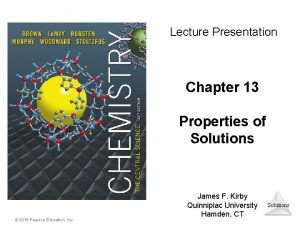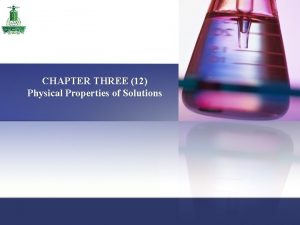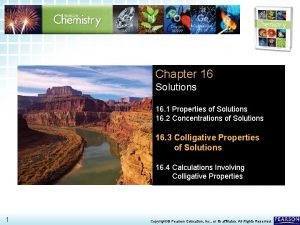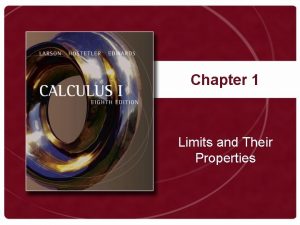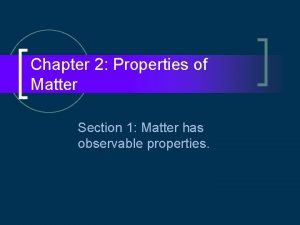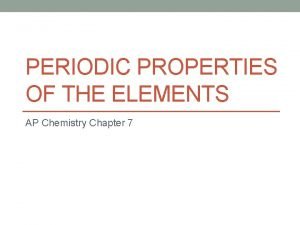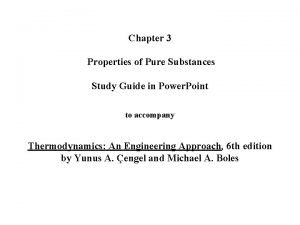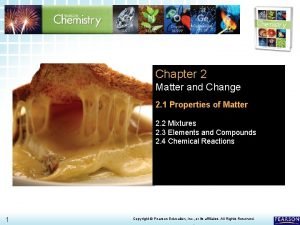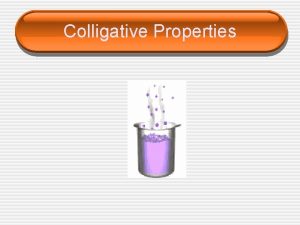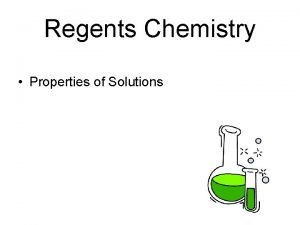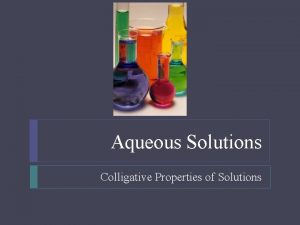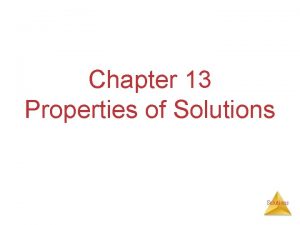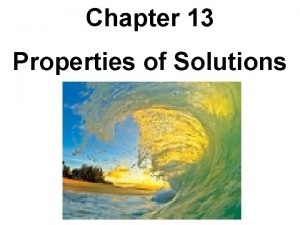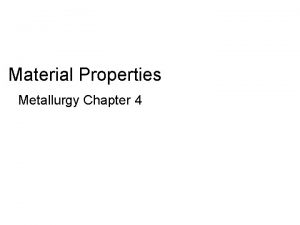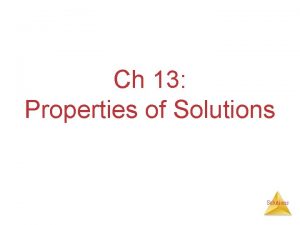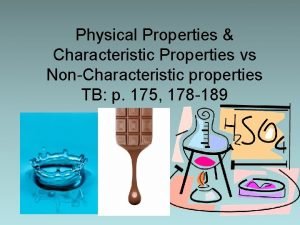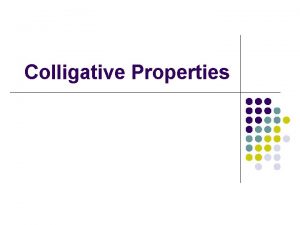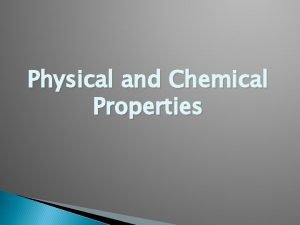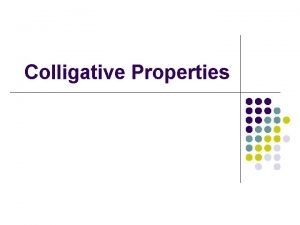Chapter 12 Properties of Solutions Solutions Solutions are

























- Slides: 25

Chapter 12 Properties of Solutions

Solutions • Solutions are homogeneous mixtures of two or more pure substances. • In a solution, the solute is dispersed uniformly throughout the solvent.

Solutions The IMFs between solute and solvent particles must be strong enough to compete with those between solute particles and solvent particles.

How Does a Solution Form? As a solution forms, the solvent pulls solute particles apart and surrounds, or solvates, them.

Types of Solutions • Saturated ØSolvent holds as much solute as is possible at that temperature. ØDissolved solute is in dynamic equilibrium with solid solute particles.

Types of Solutions • Unsaturated ØLess than the maximum amount of solute for that temperature is dissolved

Types of Solutions • Supersaturated ØSolvent holds more solute than is normally possible at that temperature.

Henry’s Law Sg = k. Pg • Sg solubility of the gas • k Henry’s law constant for that gas in that solvent • Pg partial pressure of the gas above the liquid.

Temperature Generally, the solubility of solid solutes in liquid solvents increases with increasing temperature.

Temperature • The opposite is true of gases: ØCarbonated soft drinks are more “bubbly” if stored in the refrigerator. ØWarm lakes have less O 2 dissolved in them than cool lakes.

Ways of Expressing Concentrations of Solutions

Mass Percentage mass of A in solution Mass % of A = 100 total mass of solution

Parts per Million (ppm) ppm = mass of A in solution 106 total mass of solution Parts per Billion (ppb) ppb = mass of A in solution 109 total mass of solution

Mole Fraction (X) XA = moles of A total moles in solution

Molarity (M) M= mol of solute L of solution • Because volume is temperature dependent, molarity can change with temperature.

Molality (m) m= mol of solute kg of solvent Because both moles and mass do not change with temperature, molality (unlike molarity) is not temperature dependent.

Colligative Properties • Changes in colligative properties depend only on the number of solute particles present, not on the identity of the solute particles. • Among colligative properties are: ØVapor pressure lowering ØBoiling point elevation ØFreezing point depression ØOsmotic pressure

Vapor Pressure • Because of solute-solvent intermolecular attraction, higher concentrations of solutes make it harder for solvent to escape to the vapor phase. • Thus, the vapor pressure of a solution is lower than that of the pure solvent.

Raoult’s Law PA = XAP A • XA is the mole fraction of the SOLVENT • P A is the normal vapor pressure of the solvent at that temperature

Example • Calculate the vapor pressure of a solution containing 22. 5 g of lactose (C 12 H 22 O 11) and 200. 0 g of water at 60 ᵒC. Assume that the vapor pressure of pure water at 60 ᵒC is 149 torr. • What if we tripled the amount of solute? • So…adding more solute will inc/dec VP? ?

Boiling Point Elevation and Freezing Point Depression Solute-solvent interactions also cause solutions to have higher boiling points and lower freezing points than the pure solvent.

Boiling Point Elevation Tb = i Kb m Tb is added to the normal boiling point of the solvent. i the dissociation factor…think electrolytic behavior Kb molal boiling point elevation constant, a property of the solvent m molality of solution

Freezing Point Depression • The change in freezing point can be found similarly: Tf = i Kf m Tf is subtracted from the normal freezing point of the solvent. • Here Kf is the molal freezing point depression constant of the solvent.

Osmosis • Some substances form semipermeable membranes, allowing some smaller particles to pass through, but blocking other larger particles. • In biological systems, most semipermeable membranes allow water to pass through, but solutes are not free to do so. • In osmosis, there is net movement of solvent from the area of higher solvent concentration to the are of lower solvent concentration

Osmotic Pressure • The pressure required to stop osmosis, known as osmotic pressure, , is = i( n ) RT = i. MRT V M is the molarity R is the ideal gas constant (0. 08206 L-atm/mol-K) T is temp in Kelvin
 Insidan region jh
Insidan region jh Chapter 13 properties of solutions
Chapter 13 properties of solutions Extensive and intensive properties
Extensive and intensive properties Physical property and chemical property
Physical property and chemical property Reocentral
Reocentral Physical properties of solutions
Physical properties of solutions Solute and solvent worksheet for grade 7
Solute and solvent worksheet for grade 7 Ions in aqueous solutions and colligative properties
Ions in aqueous solutions and colligative properties Colligative properties
Colligative properties General properties of aqueous solutions
General properties of aqueous solutions Visitor management solutions for properties
Visitor management solutions for properties Physical properties of solutions
Physical properties of solutions Find the measure of mn
Find the measure of mn Chapter 11 properties of the hair and scalp answers
Chapter 11 properties of the hair and scalp answers Chapter 9 properties of transformations answer key
Chapter 9 properties of transformations answer key Overview elements and their properties answer key
Overview elements and their properties answer key Chapter 10 properties of circles answers
Chapter 10 properties of circles answers Chapter 1 limits and their properties
Chapter 1 limits and their properties 2 properties of matter
2 properties of matter Milady chapter 11
Milady chapter 11 Ap chemistry chapter 7 periodic properties of the elements
Ap chemistry chapter 7 periodic properties of the elements List the properties of x radiation chapter 38
List the properties of x radiation chapter 38 Chapter 3 properties of pure substances
Chapter 3 properties of pure substances Chapter 2 properties of matter answer key
Chapter 2 properties of matter answer key Chapter 1 limits and their properties
Chapter 1 limits and their properties Limits of composite functions
Limits of composite functions

